Are you concerned about the presence of estrogen and other synthetic hormones in your drinking water? If so, you are not alone.
One way to reduce your exposure to these synthetic hormones is to use a water filter. Brita is of the most popular brands of pitcher filters on the market. But do Brita filters remove estrogen from water?
Some of Brita’s products remove estrogen and hormones from drinking water. But not all of them. The key is to find a Brita filter that uses carbon filtration as well as the right type of activated carbon.
Brita’s Longlast and Longlast+ filters can effectively remove estrogen and other synthetic hormones from drinking water. These filters use activated carbon which is an extremely effective treatment method for removing estrogen. Both the Longlast and Longlast+ filters have been NSF certified to remove specific synthetic hormones such as bisphenol A and estrone. The NSF rating is the gold standard in water treatment because the claims have been verified by an independent third party.
In this blog post, we will take a look at the science behind Brita filters and estrogen removal. We will also discuss the potential health risks associated with drinking water that contains estrogen and other hormones.
What is Estrogen
The recent discovery of estrogens in the environment has raised concerns because these compounds can affect both wildlife and humans. The incomplete removal by publicly owned treatment works (POTW) for excreted endogenous estrogen and other prescribed hormones in sewage effluent has been identified as one potential route of environmental contamination.
Estrogenic compounds such as estrone, 17β-estradiol, estriol, and ethinyl estradiol, are a category of chemicals known as endocrine disruptors. These compounds can mimic or interfere with the body’s hormones, known as the endocrine system.
Endocrine disruptors are linked with developmental, reproductive, brain, immune, and other problems.
A partial listing of estrogenic compounds of concern include:
- Estriol (16α-hydroxyestradiol)
- Estrone
- 17β-Estradiol
- 17α-Ethynylestradiol
- Equilin
- Testosterone
- Androstenedione
- Equilenin
- 17α-Estradiol
- 4-androstene-3
- Norethindrone
- Progesterone
- Bisphenol A
How does estrogen get in my water
Estrogens are found in rivers, wastewater, and drinking water throughout the United States.
Estrogen and other hormones get into drinking water through various sources, such as:
- contraceptive pills excreted through urine or feces
- agricultural uses of hormones
- industrial discharges
- landfills
Because the cattle industry employs growth-regulating steroids to boost cow growth rates, it is a major source of estrogens released into the environment.
Health concerns with estrogen and hormones
Long term exposure to hormones such as estrogen can cause a variety of health problems in both men and women. These health problems include:
- breast cancer
- testicular cancer
- developmental effects in children
- early onset of puberty in girls
- changes in sex ratio of newborns (more females)
- impaired fertility
- reduced sperm count in men
These are just a few of the potential health problems associated with exposure to estrogen. It is important to note that the health effects of estrogen exposure depend on many factors, including the amount of exposure and the length of time exposed.
Drinking water standard for estrogen and other hormones
There are no federal drinking water standards for estrogen and other hormones. The EPA establishes maximum contaminant levels, known as MCLs, for regulated compounds that are known or suspected to harm human health.
Brita Filters and Estrogen Removal
Brita makes a variety of filtration products, including pitchers, bottles, and faucet-mounted filters. The company also makes replacement filters for its products.
The Brita filters that use specialty activated carbon are the best for removing estrogen. As we’ve discussed, activated carbon (also known as charcoal) is very effective at removing a wide variety of contaminants from water, including estrogen.
The Brita Longlast and Longlast+ filters are the best options for removing estrogen from your drinking water. These filters use a type of activated carbon that is specifically designed to remove synthetic hormones like estrone and bisphenol A.
Brita Elite Longlast/Longlast+ and estrogen treatment
In my opinion, the Brita Elite is one of the best-made water filter pitchers on the market. Comparted to its competitors, it is very well-made, and it can be used with Brita’s NSF certified filters – the Longlast and Longlast+.
The Longlast and Longlast+ pitcher filters have several NSF certifications, including:
- NSF/ANSI standard 42 (aesthetics, taste, odor and chlorine)
- NSF/ANSI standard 53 (for 15 specific health contaminants)
- NSF/ANSI standard 401 (emerging contaminants such as pesticides and pharmaceuticals with estrogenic properties like estrone and bisphenol A)
Brita faucet filters and estrogen treatment
Brita’s faucet filter uses activated carbon as one of the main filters. As we’ve discussed, activated carbon is an effective way to remove estrogen from drinking water.
However, Brita did not have NSF certify their faucet filters for removal of estrogen and other hormones. This doesn’t mean that the faucet filter does not remove these contaminants – it simply means that Brita didn’t pay NSF for the required testing and evaluation.
Given the size of the filter and the amount of activated carbon it holds, it is very likely that the Brita faucet filter will remove a significant amount of estrogen from your drinking water. However, if you want a NSF certified filter, this isn’t the one for you.
What is the maximum concentration of estrogen Brita filters can remove
Brita had NSF evaluate and certify their Longlast and Longlast+ filters for removal of estrogen and hormones. These filters were tested at various influent contaminant concentrations to see how well they performed. Here are the testing results provided by NSF and Brita.
Contaminant |
Overall |
Testing |
NSF Maximum Permissible Level |
| Bisphenol A |
95.5% |
2.000 ppb |
0.300 ppb |
| Estrone |
96.4% |
0.140 ppb |
0.020 ppb |
Brita claims about estrogen
Brita does not make any claims about the ability of their filters to remove glyphosate from drinking water. Their website includes a list of contaminants their products are designed to treat. Roundup is not listed as one of the contaminants their filters can remove.
Learn more about Brita filters and the contaminants they can remove from drinking water.
Brita Product Summary
Brita has an extensive line of filtration products to meet your water treatment needs. Their filters include:
- Pitcher filters
- Faucet filters
- Bottle filters
- Dispenser filters
- Replacement filters
Brita pitcher filters
Brita has 12 pitcher filter models available. They come in capacities ranging from 6 to 12 cups, a variety of features, and many color options.
Depending on which pitcher filter you have, you can choose between three different replaceable filters. I have a review and summary of them in the section below.
Features you may want to consider include:
- Autofill lid – Pitchers with autofill lid option don’t have a lid, so you don’t have to lift it up to fill the reservoir.
- Easy-fill lid – Similar to autofill lids, pitchers with this option don’t have a lid to lift up.
- Electronic filter indicator – The filter indicator lets you know when it’s time to replace a spent filter. It is activated when the lid opens for 5-8 seconds (based on size of reservoir) and measures how much water has been treated by keeping count of the number of times it’s filled.
- Filter-As-You-Pour technology – This innovation eliminates the need for a reservoir, so you have instant access to treated water without having to wait for the entire pitcher volume to be treated.
- Locking lid – This cap prevents dust and debris from falling into the filter reservoir.
- Smart Light filter indicator – This indicator records the amount of water flowing out of the pitcher when the jug is tilted during usage. It has a green, yellow, and red indicating light to let you know how much filtration capacity is left.
Here is a summary of Brita’s current filter pitchers and their key features.
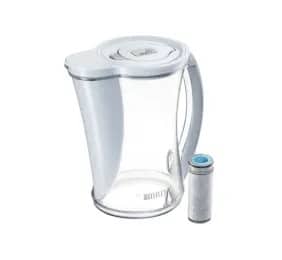
Cascade Stream Water Pitcher
Average price: $34.49
Capacity: 12-cup
Colors: White, Maroon
Features: Electronic filter indicator, Filter-As-You-Pour™ technology
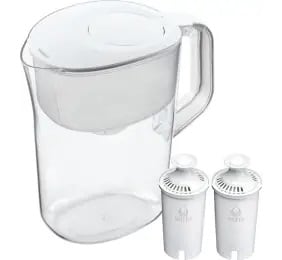
Champlain Water Pitcher
Average price: $36.99
Capacity: 10-cup
Colors: White
Features: Smart Light filter indicator
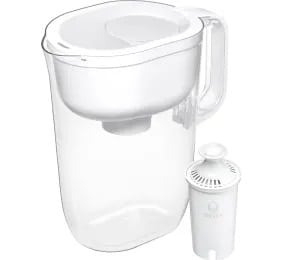
Huron Water Pitcher
Average price: $41.99
Capacity: 10-cup
Colors: White, Teal, Black, Red
Features: Smart Light filter indicator
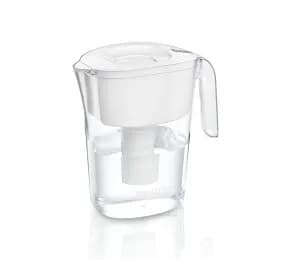
Lake Water Pitcher
Average price: $36.99
Capacity: 10-cup
Colors: White, Blue
Features: Electronic filter indicator, Autofill lid
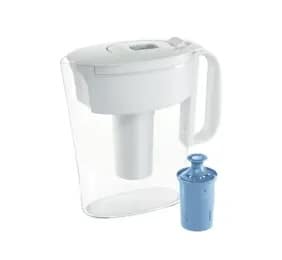
Metro Pitcher
Average price: $21.99 to $32.99
Capacity: 6-cup
Colors: White, Red, Turquoise
Features: Electronic filter indicator, Space-efficient design
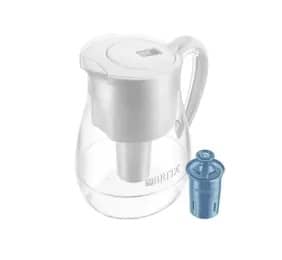
Monterey Water Pitcher
Average price: $41.99
Capacity: 10-cup
Colors: White, Blue, Black, Green
Features: Electronic filter indicator, Easy-fill lid
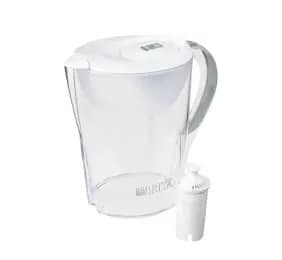
Pacifica Water Pitcher
Average price: $36.99
Capacity: 10-cup
Colors: White, Red, Black
Features: Electronic filter indicator, Easy-fill, locking lid
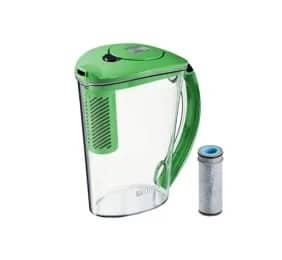
Rapids Stream Water Pitcher
Average price: $32.49
Capacity: 10-cup
Colors: Aquamarine, Grey
Features: Electronic filter indicator, Filter-As-You-Pour™ technology

SoHo Water Pitcher
Average price: $21.99
Capacity: 6-cup
Colors: White, Red, Black
Features: Electronic filter indicator, Space-efficient design
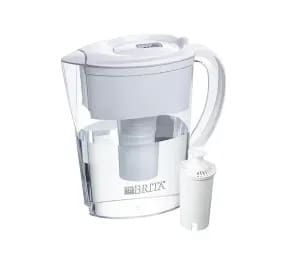
Space Saver Water Pitcher
Average price: $22.99
Capacity: 6-cup
Colors: White, Blue, Red, Black
Features: Electronic filter indicator
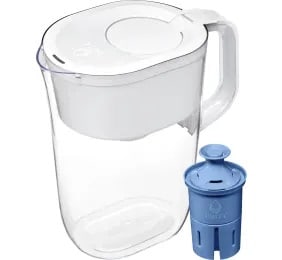
Tahoe Water Pitcher
Average price: $36.99 – $41.99
Capacity: 10-cup
Colors: White, Blue, Black, Green
Features: SmartLight filter indicator

Wave Water Pitcher
Average price: $36.99
Capacity: 10-cup
Colors: White
Features: Electronic filter indicator, Locking lid
Brita Faucet Filters
Brita has a line of faucet filters that you can install on your kitchen or bathroom faucet to provide clean drinking water.
There are two main models of Brita faucet filters with different features:
- Basic Water Filter Faucet System – This filter attaches onto any standard faucet. Itt comes with one 100-gallon filter which removes 99% lead from tap waters making them safe for drinking or cooking. It also reduces chlorine (taste/odor), benzene, asbestos, and trichloroethylene concentrations.
- Complete Water Filter Faucet System – This system attaches easily to your sink faucet and includes two 100 gallon filters. These filters remove 99% of lead as well as chlorine (taste/odor), benzene, asbestos, and trichloroethylene.
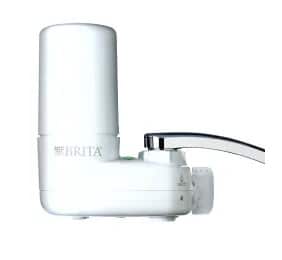
Basic Water Filter Faucet System
Average price: $19.99
Treatment capacity: 100 gallons
Contaminant removal: lead, chlorine (taste & odor)
Features: Filter replacement indicator
Colors: white, chrome
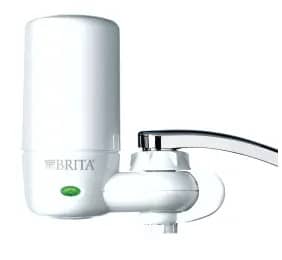
Complete Water Filter Faucet System
Average price: $19.99
Treatment capacity: 100 gallons
Contaminant removal: chlorine (taste & odor)
Features: Electronic filter indicator, 3 spray options
Colors: white
Brita Dispenser Filters
Brita has a line of dispenser filters that are designed to sit on your countertop and provide clean, filtered water for you and your family.
There are two main models of Brita dispenser filters:
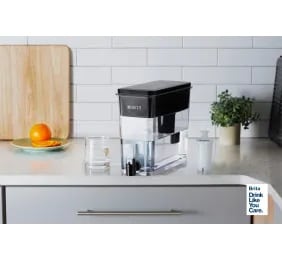
Ultramax Water Dispenser
Average price: $38.99 to $49.99
Treatment capacity: 27-cups
Features: Electronic filter replacement indicator
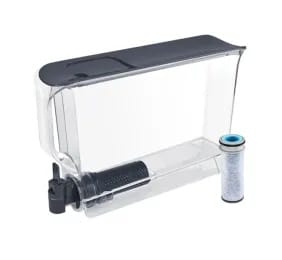
Ultraslim Stream Water Dispenser
Average price: $44.99
Treatment capacity: 25-cups
Features: Smart Light filter indicator (including auto-reset feature), Filter-As-You-Pour technology
Brita filter elements
Brita has replaceable filter elements for all of the water treatment products. The pitcher filters and Dispenser filters can use either the Elite or Standard filters.
Here is a description of the filter elements the Brita offers including pricing, capacity, service life, and other important information.

Elite filters
Average price: $19.99
Treatment capacity: 120 gallons
Service life: 6 months
Contaminant removal: removes 99% of lead; chlorine (taste & odor)
Pitcher compatibility: Fits all Brita pitchers and dispensers (except Stream)
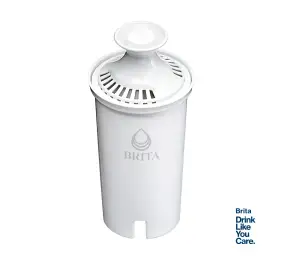
Standard filters
Average price: $7.99
Treatment capacity: 40 gallons
Service life: 2 months
Contaminant removal: chlorine (taste & odor)
Pitcher compatibility: Fits all Brita pitchers and dispensers
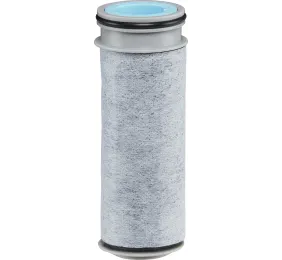
Stream filters
Average price: $7.99
Treatment capacity: 40 gallons
Service life: 2 months
Contaminant removal: chlorine (taste & odor)
Pitcher compatibility: Fits all Brita Stream pitchers and dispensers
Features: Filter-As-You-Pour technology
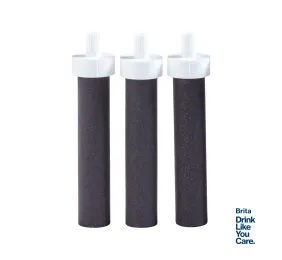
Water bottle filters
Average price: $14.99
Treatment capacity: 40 gallons
Service life: 2 months
Contaminant removal: chlorine (taste & odor)
Pitcher compatibility: Fits all Brita Premium Filtering Water Bottles
How do you replace a spent Brita filter and install a new one?
The Standard Brita pitcher filter should be replaced every two months or 40 gallons, whichever comes first. Elite filters are replaced after treating 100 gallons or every six months.
To replace your filter:
- Rinse your Brita Standard Filter with cold water for 15 seconds.
- Insert the filter into the reservoir by lining up the groove in the filter with the ridge in the reservoir. Press firmly for a tight seal.
- Add cold tap water. Discard your first three pitchers of filtered water or use it to water plants. It’s normal for carbon dust to appear in your first few fillings.
Brita Filter Maintenance
Britia filters have a consumable filter element that needs to be replaced every 100 gallons or about every four months. The frequency of replacement will depend on the specific filter you have and how much water you use.
It is important to follow the manufacturer’s instructions for replacing the filter. This will ensure your Brita filter continues to work properly.
How often do I need to replace my Brita filter
Each model of Brita filter has a recommended service life. Brita’s recommendations are summarized in the following table.
| Model | Volume of Water | Time |
| Longlast+ | 120 gallons | 6 months |
| Longlast | 100 gallons | 4 months |
| Standard Brita pitcher filter | 100 gallons | 4 months |
| Faucet filter | 100 gallons | 4 months |
Overview of Brita Filters
Brita filters are a type of pitcher filter that uses particle filtration and activated carbon adsorption to remove contaminants from drinking water. Activated carbon is a very effective treatment method for removing a wide variety of contaminant, including glyphosate, from water.
How they work
Brita filters include sediment filters and granular activated to purify drinking water. The activated carbon in the filters adsorbs a wide range of contaminants such as VOCs, solvents, herbicides, and pesticides from the water.
Water is poured into the pitcher reservoir where it flows via gravity through the filters. The contaminants are adsorbed to the activated carbon in the filters and the clean water is collected in the pitcher.
NSF certification
NSF International is an independent organization that tests and certifies products to ensure they meet safety and performance standards. Several Brita filters are certified by NSF to remove a wide range of contaminants from drinking water, including VOCs, solvents, herbicides, and pesticides.
NSF certification is a great way to confirm the claims made by equipment manufacturers. NSF conducts testing in accordance with strict protocols and issues certifications to products that meet their standards.
FAQs
Do any water filters remove estrogen and hormones?
Several treatment technologies are known to be effective at removing estrogen and hormones from water. Proven methods for treating synthetic hormones include reverse osmosis, distillation, activated carbon, and nanofiltration.
Does boiling water remove estrogen from drinking water?
Boiling water does not remove estrogen or other hormones. In fact, boiling water will increase the concentration because the water evaporates but the estrogen remains behind.
What chemicals do Brita filters remove?
Britia filters remove a wide range of contaminants from water, including VOCs, solvents, herbicides, and pesticides.
Final Take on Brita Filters and Estrogen
Estrogen is a contaminant in drinking water that many people are concerned about. Brita makes two filters – the Longlast and Longlast+, they can remove estrogen from your drinking water.
These filters use a type of activated carbon that is specifically designed to remove synthetic hormones like estrone and bisphenol A. They are also NSF certified to reduce the concentration of these contaminants to safe levels.

